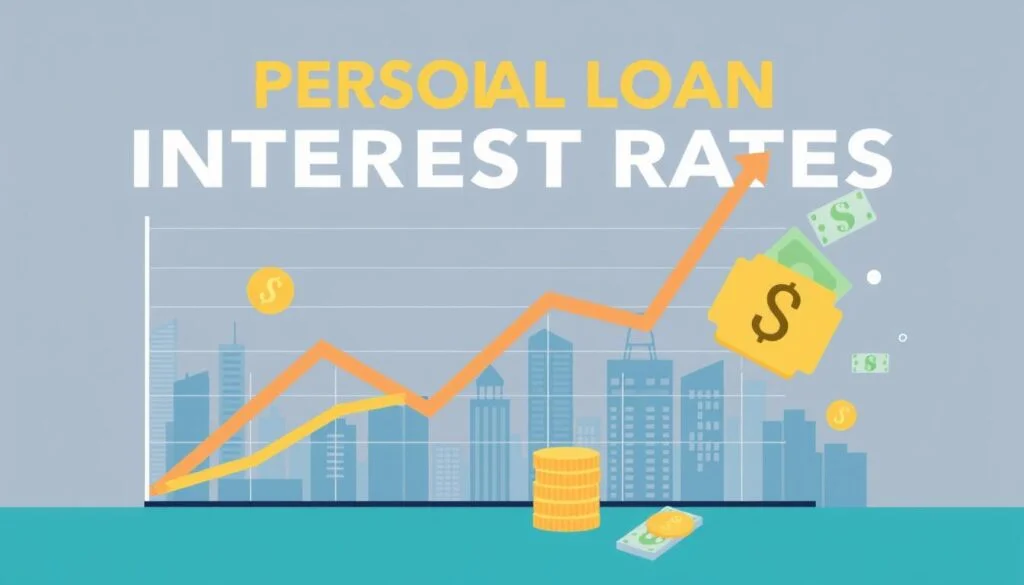Did you know the average personal loan interest rate in the United States was around 25.94% in 2024? This shows how key it is to grasp personal loan interest rates. Personal loans are a common type of credit. Borrowers get a sum of money and pay it back in fixed monthly payments over a set time. The interest rate given is the annual percentage rate (APR), which shows the real cost of borrowing, including fees and other charges.
Understanding Personal Loan Interest Basics
Understanding personal loan interest is key. The Annual Percentage Rate (APR) shows the yearly cost of borrowing. It includes interest and fees. This rate helps borrowers see the loan’s true cost and compare offers.
It’s also important to know the difference between nominal and effective interest rates. The nominal rate is the interest rate stated. The effective rate includes compounding, giving a clearer picture of the loan’s cost over time. This is especially true for personal loans, where the monthly rate affects the total repayment.
Regulation Z requires lenders to share important loan details. This includes the APR, finance charges, and total payments. This law helps borrowers understand the loan’s cost and compare options. In 2024, the average personal loan interest rate was 25.94%. But rates can change based on the lender and the borrower’s credit score.
“Borrowers should always review the APR, not just the stated interest rate, to get a comprehensive understanding of the true cost of a personal loan.”
Learning about these basics helps borrowers make better choices. They can find the best loan terms and lower their borrowing costs.
Factors That Influence Personal Loan Interest Rates
Personal loan interest rates can change a lot based on several important factors. Your creditworthiness, the loan length, and how much lenders think they’ll make from you all matter. These factors help decide how much you’ll pay in interest.
Your credit score is a big factor in your loan rate. People with high scores, above 720, usually get the best rates. This is because they’re seen as less likely to default. Lenders also look at your job and how much you make to judge your creditworthiness.
The loan length also affects your rate. Loans that last longer, like 5 or 7 years, often have lower rates. This is because lenders make more money over time, making the loan less risky for them.
Another important factor is the cost of borrowing for banks. The federal funds rate set by the Federal Reserve affects how much banks charge each other. These costs are then passed on to you in the form of your loan rate.
Lastly, the collateral you offer can also change your rate. Secured loans, where you use something like a car or house as collateral, usually have lower rates. This is because the lender’s risk is lower since they can take the collateral if you default.
| Factors | Impact on Personal Loan Interest Rates |
|---|---|
| Creditworthiness | Higher credit scores lead to lower rates due to lower default risk |
| Loan Length | Longer-term loans often have lower rates as lenders make more money over time |
| Collateral | Secured loans backed by collateral offer lower interest rates than unsecured loans |
| Cost of Borrowing | The federal funds rate influences banks’ borrowing costs, which are passed on to consumers |
Knowing what affects personal loan interest rates can help you make better choices. This is true whether you’re looking to debt consolidate or for other financial needs.
Types of Personal Loan Interest Calculations
Lenders use three main ways to figure out interest on personal loans: simple interest, compound interest, and add-on interest. Knowing these methods helps borrowers compare loans and choose wisely.
Simple Interest Method
The simple interest method is also known as the U.S. Rule. It applies the interest rate only to the loan’s principal. This means the interest stays the same, avoiding the “interest on interest” trap seen in compound interest.
Compound Interest Method
The compound interest method adds interest to both the principal and any unpaid interest from before. This can make the total interest paid higher, especially if payments are late. It’s often used for mortgages and car loans, where the interest goes down as the principal is paid off.
Add-on Interest Method
The add-on interest method calculates interest upfront and adds it to the principal. This leads to equal monthly payments, but more goes to interest early on. It’s the least favorable for borrowers, as it results in the highest total interest paid.
Knowing these interest methods helps borrowers pick the right personal loan. They should also think about loan amortization and repayment plans when comparing offers.
Secured vs. Unsecured Personal Loan Rates
Personal loans come in two types: secured and unsecured. The main difference is whether they require collateral or not. This affects the interest rates and how easy it is to get the loan.
Secured loans use something valuable like a car or home as collateral. This makes the loan less risky for the lender. So, they usually offer lower interest rates than unsecured loans. In fact, secured loans can be up to 20 percent cheaper.
Unsecured loans, however, don’t require collateral. Since they’re riskier, lenders charge more interest rates. These rates can be as high as 36 percent. As of February 2023, the average APR for a 24-month unsecured loan is 11.48 percent.
Choosing between secured and unsecured loans depends on your situation. Secured loans might have lower rates but risk losing your asset if you can’t pay back. A personal loan calculator can help you see the costs and benefits of each option.
| Loan Type | Interest Rate | Borrowing Limit | Collateral Requirement |
|---|---|---|---|
| Secured Personal Loan | 20% lower than unsecured loans | Higher | Yes (e.g., home, car) |
| Unsecured Personal Loan | 6% to 36% | Up to $100,000 | No |
The right choice between secured and unsecured loans depends on your financial situation and goals. Knowing the differences in interest rates, loan approval process, and collateral requirements helps you make a smart decision.
How Credit Scores Impact Your Personal Loan Interest Rate
Your credit score is key in setting your personal loan interest rate. Lenders see it as a sign of how reliable you are with money. A higher score means you might get a lower rate. Most lenders want scores over 800 for the best rates.
Credit Score Requirements
Lenders look for scores over 670 to feel confident in lending. But, each lender has its own score needs. If you have a good credit score (670 or higher), you might get a better rate. Scores under 580 can make it hard to get a loan or lead to higher rates.
Ways to Improve Your Rate Through Credit Management
Boosting your credit score can help you get better loan terms. Your credit report and FICO score depend on payment history, how much credit you use, and how long you’ve had credit. Paying on time and using less credit can improve your score and lower your loan rate.
Impact of Payment History
Your payment history is crucial for your credit score. Lenders value on-time payments as a sign of good debt management. Late payments can hurt your score, leading to higher rates or even loan denials.
Understanding Loan Terms and Payment Structure
When you get a personal loan, knowing how you’ll pay it back is key. Loans usually last from one to seven years. Longer repayment periods mean smaller monthly installments, but you’ll pay more interest over time.
Personal loans often have fixed monthly payments that cover both the loan and interest. Some loans might have variable rates or need a big payment at the end. It’s important to read the whole loan agreement before you agree to it.
| Loan Type | Typical Repayment Period | Average Interest Rates |
|---|---|---|
| Mortgage Loans | 30 years | 3-7% |
| Auto Loans | 5 years | 4-10% |
| Student Loans | 10 years | 4-12% |
| Personal Loans | 1-7 years | 6-36% |
It’s smart to check the loan terms closely. Look at the repayment period, monthly installments, and any extra fees. This helps you choose the best loan agreement for your money.
“Understanding the full loan agreement, including any prepayment penalties or fees, is crucial before accepting a loan offer.”
How to Compare Personal Loan Offers
When you’re looking at personal loan offers, don’t just focus on the interest rate. The Annual Percentage Rate (APR) gives you a clearer picture. It includes the interest rate and any fees, like origination fees.
Origination fees can be between 0.99% and 9.99% of the loan amount. For loans lasting 4 years or more, the fee is usually at least 4.99%. These fees can greatly affect the loan’s total cost. So, it’s key to include them when comparing offers.
Also, check if there are prepayment penalties for early repayment. Some lenders charge these, while others don’t. Always read the fine print before you agree to a loan. By looking at the APR, fees, and prepayment rules, you can choose the best loan for your needs.


Comments are closed.